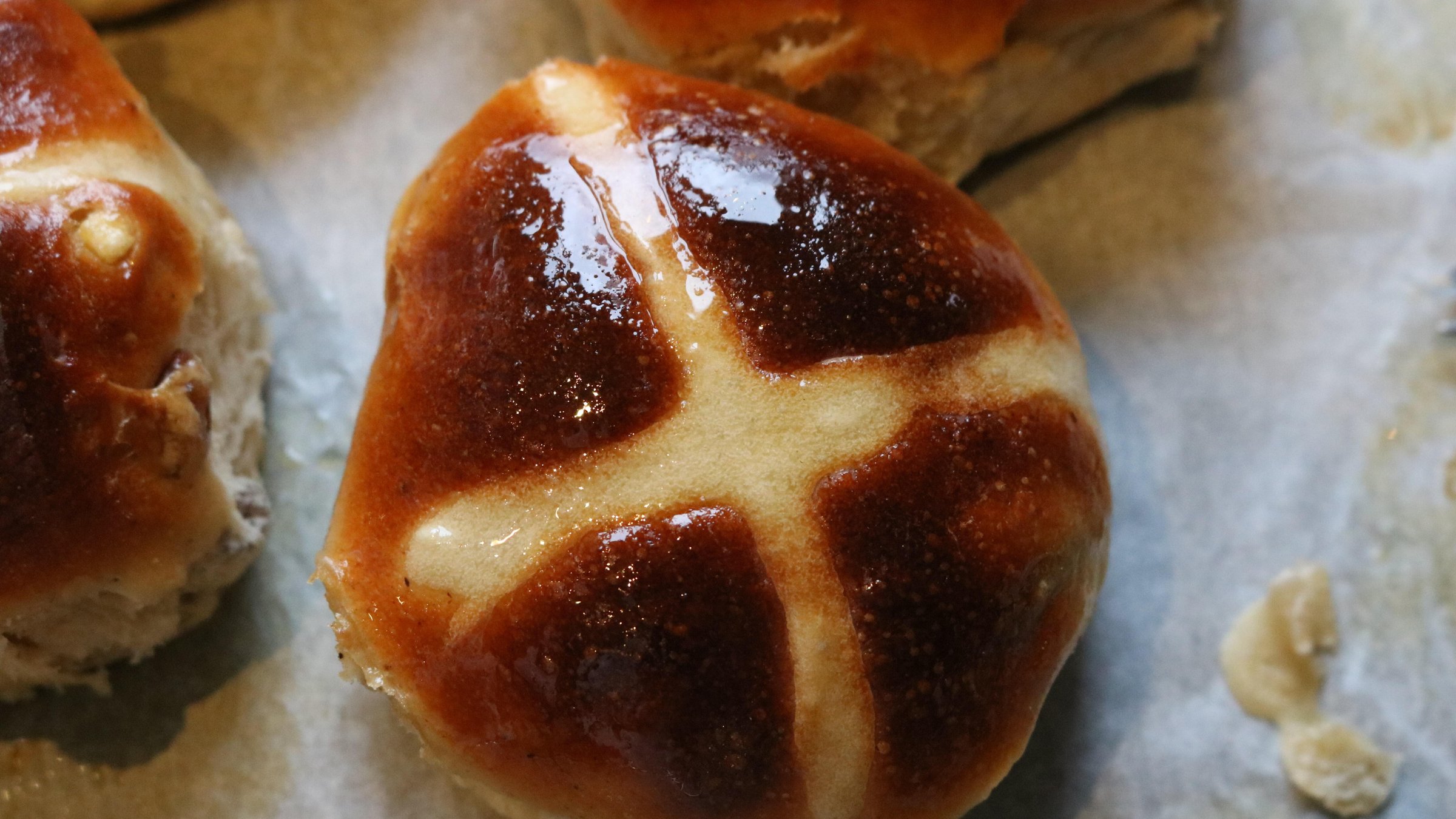“Hot cross buns! Hot cross buns!
One a penny, Two a penny, Hot cross buns!
If you have no daughters, Give them to your sons,
One a penny, Two a penny, Hot cross buns!"
Seventy years ago, I heard this nursery rhyme from a somewhat older phonograph record — the 78 rpm discs made of shellac. Hot cross buns (recipe here) were no mystery to me in my youth. My parents enjoyed pastries, and Van De Kamp’s made the iced buns available during Lent.
By long-standing custom each year, the Church devotes the entire month of April to adoring Jesus Christ in the Most Blessed Sacrament of the Altar. Fittingly, Holy Thursday in 2023 occurs on April 6. On that day is celebrated the anniversary of Our Lord’s institution of the Most Holy Sacrifice of the Mass, the rites of which are so intimately connected to His atoning Crucifixion on Good Friday. By giving us the wondrous Gift of Himself in Holy Communion, Jesus fulfills the promise He made to the Twelve, “I will not leave you orphans” (John 14:18).
This present tale about the origin of hot cross buns is found in a little book of legends and plays called The Little Flowers of Saint Francis. It should be taken neither too seriously — nor too lightly.
When Francis of Assisi first came to Rome in 1209 to gain Pope Innocent III’s tacit approval of his order of friars, the “Little Brothers,” Cardinal Ugolino dei Conti di Segni supported the effort and gave Francis much assistance. Some years later, upon receiving written authorization from Pope Honorius III, Francis requested Cardinal Ugolino be named cardinal protector for the Franciscans, both men and women.
Mind you, while Cardinal Ugolino revered both Brother Francis and his good friend Sister Clare, who led the Franciscan nuns called the “Poor Ladies,” he always thought it unseemly for ladies, especially highborn ladies who entered the Franciscan life, to beg for food and clothing. Wishing to make life easier for others seeking to join this mendicant order who might not share Francis and Clare’s zeal, he suggested ways to mitigate devotion to what Francis described as Lady Poverty. Cardinal Ugolino was uncomfortable with the word mendicant, knowing that it means “begging.”
Brother Francis died in 1226. The following year, Cardinal Ugolino was elected supreme pontiff under the style Pope Gregory IX. He experienced the joy of raising his friend to the altar, proclaiming him St. Francis in 1228.
A few years later, asked to confirm the Privilege of Poverty granted St. Clare by Pope Innocent in 1214, Gregory wondered how well this dispensation was working. He therefore informed Sister Clare of his intention to call on the Poor Ladies in Assisi.
The sisters all set to work. They scrubbed the monastery’s stone floors. They oiled and polished the rough wooden refectory tables where they ate. The walls were decked with garlands of flowers. Sister Clare also had a special loaf of bread baked for each of her sisters that day in honor of the pontiff’s visitation. After they had been blessed by the Vicar of Christ, Sister Clare allowed that her sisters might keep the loaves if they so desired.
Upon his arrival, Pope Gregory spoke with Sister Clare and the other Poor Ladies and realized his anxiety had been for naught. They were not merely happy with their lives of poverty and renunciation; they positively radiated a supernatural joy in knowing how their shared love for Jesus came alive by aiding and comforting the poor.
Escorting Pope Gregory into the refectory, Sister Clare asked him to bless the loaves of bread on the tables. According to the Little Flowers, “believing that Clare was a shrine of the Holy Spirit,” the pope answered: “'Very faithful Sister Clare, I want you to bless those loaves of bread and to make over them the Sign of the Cross of Christ.'
“But Clare replied, ‘Most Holy Father, please excuse me, but I would deserve to be severely blamed if a vile little woman like myself should presume to give such a blessing in the presence of the Vicar of Christ.'
“The pope answered: ‘So that it should not be attributed to presumption but that you may also earn merit by doing it, I command you, under holy obedience, to make the Sign of the Cross over these loaves of bread and bless them in the name of Our Lord Jesus Christ.’
“Only then St. Clare, as a truly obedient daughter, very devoutly made the Sign of the Cross over those loaves of bread and blessed them. When she did this, a marvelous thing happened! All of a sudden, a very beautiful cross, clearly marked, appeared on each of the loaves. Some of those loaves were later eaten with great devotion, and some were set aside as evidence of the miracle for the future.”
The Franciscans brought this story to England. In 1361, Fr. Thomas Rockcliffe distributed buns marked by a cross to the poor of St. Albans. The loaf was to commemorate the union of the Holy Eucharist and the Crucifixion, and rightly so. And a tradition was begun in England and Ireland that lasts to this day as a sweet reminder of the joy of our salvation, a tasty confection with a great little theology lesson baked into it.
Sean M. Wright, MA, is an Emmy nominee and a Master Catechist for the Archdiocese of Los Angeles. He is a parishioner at Our Lady of Perpetual Help in Santa Clarita and answers comments or questions at [email protected].












